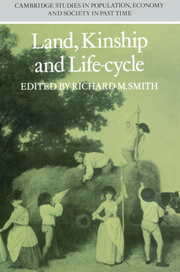Book contents
- Frontmatter
- Contents
- List of contributors
- Preface
- 1 Some issues concerning families and their property in rural England 1250–1800
- 2 Population pressure, inheritance and the land market in a fourteenth-century peasant community
- 3 Families and their land in an area of partible inheritance: Redgrave, Suffolk 1260–1320
- 4 Population changes and the transfer of customary land on a Cambridgeshire manor in the fourteenth century
- 5 Industrial employment and the rural land market 1380– 1520
- 6 Changes in the size of peasant holdings in some west midland villages 1400–1540
- 7 The erosion of the family–land bond in the late fourteenth and fifteenth centuries: a methodological note
- 8 Changes in the link between families and land in the west midlands in the fourteenth and fifteenth centuries
- 9 Kinship in an English village: Terling, Essex 1550–1700
- 10 The myth of the peasantry: family and economy in a northern parish
- 11 Poverty, poor relief and the life-cycle: some evidence from seventeenth-century Norfolk
- 12 The receipt of poor relief and family situation: Aldenham, Hertfordshire 1630–90
- 13 Widows in pre-industrial society: an essay upon their economic functions
- 14 Real property, marriage and children: the evidence from four pre-industrial communities
- 15 The nineteenth-century peasantry of Melbourn, Cambridgeshire
- Consolidated Bibliography
- Index
5 - Industrial employment and the rural land market 1380– 1520
Published online by Cambridge University Press: 19 October 2009
- Frontmatter
- Contents
- List of contributors
- Preface
- 1 Some issues concerning families and their property in rural England 1250–1800
- 2 Population pressure, inheritance and the land market in a fourteenth-century peasant community
- 3 Families and their land in an area of partible inheritance: Redgrave, Suffolk 1260–1320
- 4 Population changes and the transfer of customary land on a Cambridgeshire manor in the fourteenth century
- 5 Industrial employment and the rural land market 1380– 1520
- 6 Changes in the size of peasant holdings in some west midland villages 1400–1540
- 7 The erosion of the family–land bond in the late fourteenth and fifteenth centuries: a methodological note
- 8 Changes in the link between families and land in the west midlands in the fourteenth and fifteenth centuries
- 9 Kinship in an English village: Terling, Essex 1550–1700
- 10 The myth of the peasantry: family and economy in a northern parish
- 11 Poverty, poor relief and the life-cycle: some evidence from seventeenth-century Norfolk
- 12 The receipt of poor relief and family situation: Aldenham, Hertfordshire 1630–90
- 13 Widows in pre-industrial society: an essay upon their economic functions
- 14 Real property, marriage and children: the evidence from four pre-industrial communities
- 15 The nineteenth-century peasantry of Melbourn, Cambridgeshire
- Consolidated Bibliography
- Index
Summary
Studies of the medieval village land market have revealed a kaleidoscopic pattern of change in the methods of land transference, as first one and then another of the means, encapsulated in the nineteenth-century adage concerning rustic advancement, ‘patrimony, matrimony and parsimony’, came to the fore, in changing economic and social circumstances, as the principal modes of property transference. Gradually the chronology and form of these changes are being charted, and although the indicators are fewer and more widely dispersed for the later middle ages than for the century and a half before the catastrophic collapse of population in the 1380s, the broad outlines of change seem to be slowly emerging. Irresistibly, the increasing importance of the cash nexus seems to be revealed as the dominant theme pervading the rustic land market during the years 1380–1520. Yet, whilst the changing pattern of land transfer – the shift from a non-monetary system, dominated by marital–inheritance transactions, to a commercial one – is slowly revealed, less attention has been paid to the mechanisms utilized by the peasant in his market operations. We know little of how the unendowed son or landless man courted the young heiress or ageing widow and how he overcame the stigma associated with his position, in order to make the contacts necessary to establish himself on the path to that tryst which would be consummated over the scrivener's table.
- Type
- Chapter
- Information
- Land, Kinship and Life-Cycle , pp. 227 - 276Publisher: Cambridge University PressPrint publication year: 1985
- 1
- Cited by



